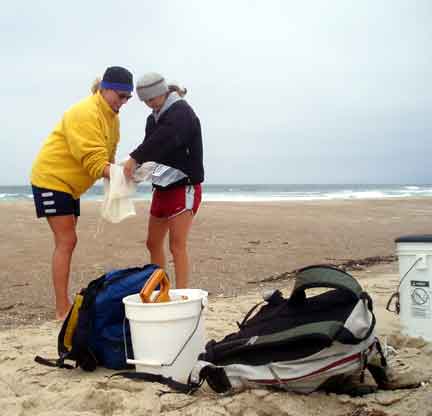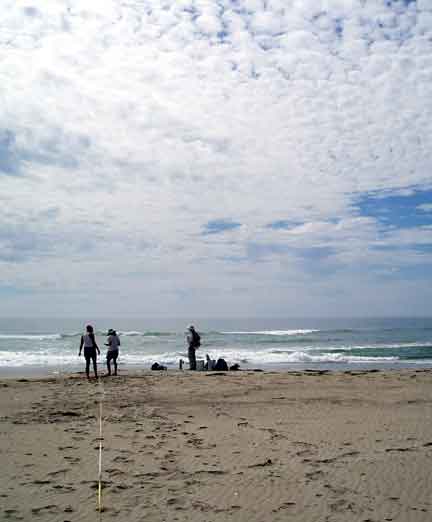|
UTILIZATION
OF SANDY
BEACHES BY SHOREBIRDS:
RELATIONSHIPS TO POPULATION CHARACTERISTICS OF MACROFAUNA
PREY SPECIES AND BEACH
MORPHODYNAMICS
Principal
Investigator: Jenifer Dugan (UCSB)
Introduction
 Sandy
beaches comprise three-quarters of the world's shorelines and
cover much of the California coast including 93% of the Ventura County coast. Their high prevalence means that sandy beaches are
likely to receive the majority of contamination from a spill or other impact
associated with oil and gas activities. Many species of migratory,
wintering and breeding shorebirds utilize Southern California's sandy beaches.
Lethal and sublethal effects of oil spills on birds are well known yet, little
information exists on the potential risk fr Sandy
beaches comprise three-quarters of the world's shorelines and
cover much of the California coast including 93% of the Ventura County coast. Their high prevalence means that sandy beaches are
likely to receive the majority of contamination from a spill or other impact
associated with oil and gas activities. Many species of migratory,
wintering and breeding shorebirds utilize Southern California's sandy beaches.
Lethal and sublethal effects of oil spills on birds are well known yet, little
information exists on the potential risk fr om
oil related impacts to shorebirds and to resources which
they depend upon on sandy beaches of Southern California. To address this
gap in information needed for oil spill contingency planning and damage
assessment, the distribution and abundance of shorebirds on Ventura County
beaches were studied by Minerals Management personnel. This study complements that project by examining factors which could
affect the distribution and abundance of shorebirds on beaches, including prey
availability and beach type. The combined results of the Minerals
Management Service study and the proposed study will address a major gap in our
understanding of the vulnerability of sandy beach resources to oil related
impacts. om
oil related impacts to shorebirds and to resources which
they depend upon on sandy beaches of Southern California. To address this
gap in information needed for oil spill contingency planning and damage
assessment, the distribution and abundance of shorebirds on Ventura County
beaches were studied by Minerals Management personnel. This study complements that project by examining factors which could
affect the distribution and abundance of shorebirds on beaches, including prey
availability and beach type. The combined results of the Minerals
Management Service study and the proposed study will address a major gap in our
understanding of the vulnerability of sandy beach resources to oil related
impacts.
 Many
shorebirds utilize sandy beaches for feeding, roosting and breeding in Ventura
county. Shorebirds occurring on sandy beaches consist of migrant,
wintering, and breeding or resident species. The distribution, abundance
and utilization patterns or shorebird species on a beach may be related to a
variety of factors including: prey availability, beach morphodynamic type, width
and condition, macrophyte wrack cover, time of year, and human activity.
The research investigates the abundance and distribution of macrofauna prey of shorebirds and beach morphodynamics, factors which
potentially affect the distribution of shorebirds on sandy
beaches and their utilization of sandy beach resources. Many
shorebirds utilize sandy beaches for feeding, roosting and breeding in Ventura
county. Shorebirds occurring on sandy beaches consist of migrant,
wintering, and breeding or resident species. The distribution, abundance
and utilization patterns or shorebird species on a beach may be related to a
variety of factors including: prey availability, beach morphodynamic type, width
and condition, macrophyte wrack cover, time of year, and human activity.
The research investigates the abundance and distribution of macrofauna prey of shorebirds and beach morphodynamics, factors which
potentially affect the distribution of shorebirds on sandy
beaches and their utilization of sandy beach resources.
|
[homepage]
|
[overview]
|
[researchers]
| [students
& staff]
|
[research] | [download reports]
|
|

